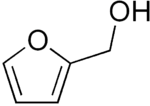Furfuryl alcohol
| Furfuryl alcohol[1] | |
|---|---|
 | |
| IUPAC name 2-furanmethanol | |
| Other names 2-furancarbinol | |
| Identifiers | |
| CAS number | 98-00-0 |
| PubChem | 7361 |
| ChemSpider | 7083 |
| UNII | D582054MUH |
| ChEBI | CHEBI:207496 |
| ChEMBL | CHEMBL308187 |
| Jmol-3D images | Image 1 |
| |
| |
| Properties | |
| Molecular formula | C5H6O2 |
| Molar mass | 98.10 g/mol |
| Density | 1.128 g/cm3 |
| Melting point | −29 °C; −20 °F; 244 K |
| Boiling point | 170 °C; 338 °F; 443 K |
| Solubility in water | miscible |
| Hazards | |
| MSDS | External MSDS |
| NFPA 704 |
 2
3
1
|
| Except where noted otherwise, data are given for materials in their standard state (at 25 °C (77 °F), 100 kPa) | |
| Infobox references | |
Furfuryl alcohol, also called 2-furylmethanol or 2-furancarbinol, is an organic compound containing a furan substituted with a hydroxymethyl group. It is a clear colorless liquid when pure, but becomes amber colored upon prolonged standing. It possesses a faint burning odor and a bitter taste. It is miscible with but unstable in water. It is soluble in common organic solvents. Upon treatment with acids, heat and/or catalysts, furfuryl alcohol can be made to polymerize into a resin, poly(furfuryl alcohol).
Furfuryl alcohol is manufactured industrially by the catalytic reduction of furfural which is obtained from corncob and sugar cane bagasse. It finds use as a solvent, but is primarily used as an ingredient in the manufacture of various chemical products such as foundry resins, adhesives, and wetting agents.
Furfuryl alcohol has been used in rocketry as a fuel which ignites hypergolically (immediately and energetically in contact) with white fuming nitric acid or red fuming nitric acid oxidizer.[2] The use of hypergolics avoids the need for an igniter. In fall of 2012, Spectra, a concept liquid rocket engine using white fuming nitric acid as the oxidizer to furfuryl alcohol fuel was static tested by Copenhagen Suborbitals.[3][4]
Furfuryl alcohol is probably a BK channel agonist.
Because of its low molecular weight, furfuryl alcohol can impregnate the cells of wood, where it can be polymerized and bonded with the wood by heat, radiation, and/or catalysts or additional reactants. The treated wood has improved moisture-dimensional stability, hardness, and decay and insect resistance; catalysts can include zinc chloride, citric or formic acid, or borates.[5][6]
Uses
The major use of furfuryl alcohol is in the production of resins for bonding foundry sands for production of cores and molds.[citation needed] The binder system contains furfuryl alcohol in monomer or polymer form.
References
- ↑ Merck Index, 11th Edition, 4215.
- ↑ Ignition Catalysts for Furfuryl Alcohol—Red Fuming Nitric Acid Bipropellant AIAA Journal Vol 8, No. 5 Pg 988.
- ↑ Madsen, Peter. "Spectra-testen". Retrieved September 10, 2012.
- ↑ http://copenhagensuborbitals.com/public/spectra.pdf The Spectra engine test report pdf
- ↑ Stamm, Alfred (June 1, 1977). "Dimensional Stabilization of Wood with Furfuryl Alcohol Resin". Wood Technology: Chemical Aspects. AMERICAN CHEMICAL SOCIETY. pp. 141–149.
- ↑ Ergun Baysal et al (21 Aug 2004). "Dimensional stabilization of wood treated with furfuryl alcohol catalysed by borates". Wood Science & Technology 38 (6).
External links
- Health hazards
- CDC - NIOSH Pocket Guide to Chemical Hazards
- Literature: K.J. Zeitsch,The Chemistry and Technology of Furfural and its Many By-Products, Elsevier, 2000